Xylophanes chiron nechus
|
|
Updated as per
AN ANNOTATED CHECKLIST OF THE SPHINGIDAE OF BOLIVIA, October 2007
Updated as per http://www.pybio.org/SPHINGINAE.htm (Paraguay), October 2007
Updated as per personal communication with Ezequiel Osvaldo Núñez Bustos, Argentina, March 2008
Updated as per personal communication with Ezequiel Bustos (Aguas Blancas, Salta, Argentina, 405m); December 2009
Updated as per CATE Sphingidae (Brazil, Petropolis); April 20, 2011
Updated as per personal communication with Andres Urbas (Camp Caiman near Kaw, French Guiana, April 1, 2011); May 7, 2011
Updated as per personal communication with Larry Valentine (Itanhandu, Minas Gerais, Brazil, October 14, 2011); October 16, 2011
Updated as per personal communication with Humberto Calero Mejia (92mm, Isla Gorgona, Cauca, Colombia, June 5, 2011; 0m); December 20, 2011
|
Xylophanes chiron nechus
zail-AH-fan-eesmmKYE-ronmm NECK-uhs
(Cramer, 1777) Sphinx
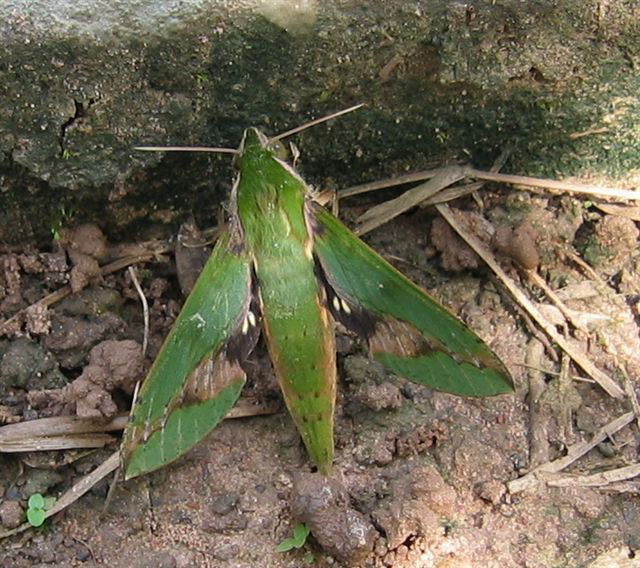
Xylophanes chiron nechus female, courtesy of
Eurides Furtado.
This site has been created by
Bill Oehlke at oehlkew@islandtelecom.com
Comments, suggestions and/or additional information are welcomed by Bill.
TAXONOMY:
Family: Sphingidae, Latreille, 1802
Subfamily: Macroglossinae, Harris, 1839
Tribe: Macroglossini, Harris, 1839
Genus: Xylophanes Hubner [1819] ...........
Species: chiron nechus (Cramer, 1777)
|
MIDI MUSIC
.....It's a Wonderful World.....
copyright C. Odenkirk
ON.OFF
<bgsound src="world.mid" LOOP=FOREVER>
|
DISTRIBUTION: Xylophanes chiron
nechus (wingspan: approximately 92mm) fly in the West Indies (specimen type locality),
and also occur in
Colombia: Cauca: Isla Gorgona (0m, HCM);
French Guiana: Kaw;
Bolivia:
Santa Cruz: Potrerillos del Güendá; Florida, Mataral; Pampa Grande;
Ichilo, La Víbora; Buena Vista; Sarah;
La Paz: Murillo, Cota Cota; Zongo, Cuticucho;
Beni: Espíritu, Cabaña;
Cochabamba: Carrasco, Chapare;
Brazil: Petropolis; Minas Gerais: Itanhandu; and
Paraguay:
Concepcion, San Pedro, Canindeyu, Alto Parana, Cordillera, Central,
Paraguari, Guaira, Caaguazu, Caazapa, (probably Itapua (WO??));
northern Argentina: Misiones, Salta (405m EB).
It is also reported in Mexico and Belize. The moth is probably very
widespread in its range.
X. c. nechus, December 23, 2005, Misiones Province, near
Puerto Iguazu, near light at night, courtesy of Oz Rittner. | 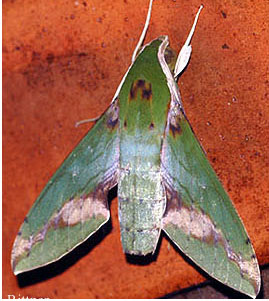 |
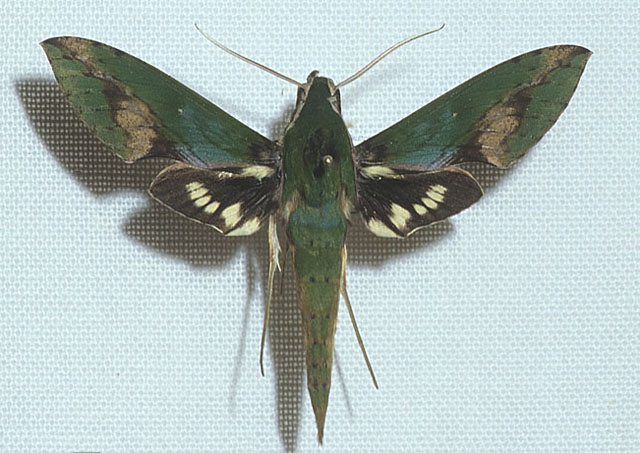
Xylophanes chiron nechus male, courtesy of Hubert Mayer
copyright.
CATE: "Very similar to Xylophanes chiron chiron but brown pattern elements of forewing upperside better developed. Moths in which the
ground colour is brown rather than green do occur but are very rare.
"Pale brown scaling along fourth postmedian line more strongly developed, in particular the patch running from M2 to the inner margin is broader and more
ovate rather than narrowly triangular."
FLIGHT TIMES:
Xylophanes chiron nechus adults
have been taken in December in Argentina. Ezequiel Osvaldo Núñez Bustos
reports a February flight in Misiones Province, Argentina.
There are probably multiple
broods elsewhere. Andres Urbas confirms an April 1, 2011, flight near Kaw, French Guiana.
Larry Valentine reports a mid October flight, 2011, in Itanhandu, south eastern Minas Gerais, Brazil.
Humberto calero Mejia reports a June 5, 2011 flight on Isla Gorgona, Cauca, Colombia.
Visit Xylophanes chiron nechus, Itanhandu, Minas Gerais, Brazil, courtesy
of Larry Valentine.
Visit Xylophanes chiron nechus recto and verso, Isla Gorgona, Cauca, Colombia, June 5, 2011,
courtesy of Humberto Calero Mejia.
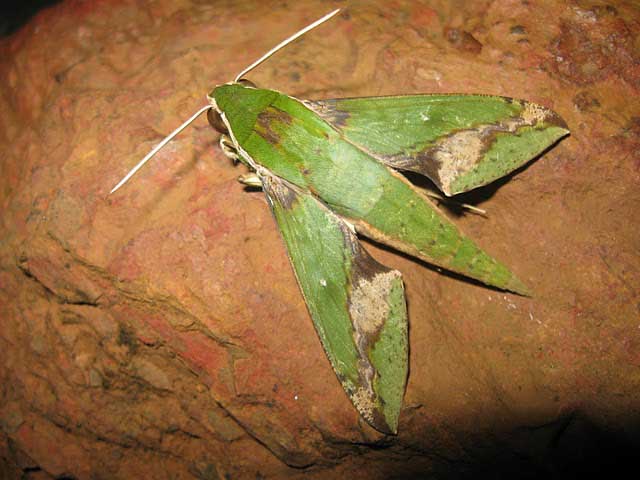
Xylophanes chiron nechus, Camp Caiman, near Kaw, French Guiana,
April 1, 2011, courtesy of Andres Urbas.
ECLOSION:
Pupae probably wiggle to surface from subterranean chambers just prior to eclosion.
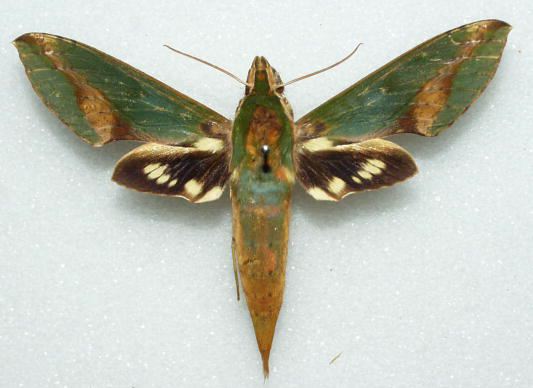
Xylophanes chiron nechus male, Mexico, courtesy of
Manuel Balcazar-Lara.

Xylophanes chiron nechus female, courtesy of Hubert Mayer
copyright.
SCENTING AND MATING:Females call in the males with a pheromone released from a gland at the tip of the
abdomen. Males come in to lights very readily, but females are
seldom taken in that way.
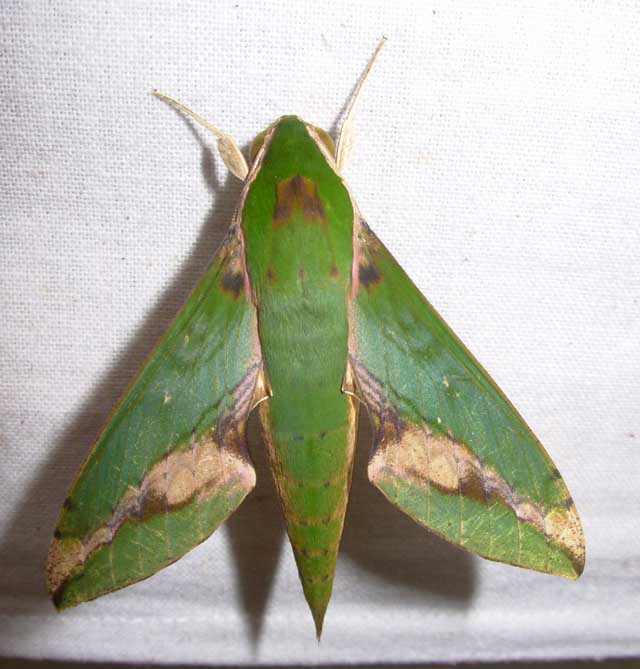
Xylophanes chiron nechus, Yacutinga Private Reserve, Misiones Province,
(near border between Argentina and Brazil), February, 2008
courtesy/copyright of Ezequiel Osvaldo Núñez Bustos.
EGGS, LARVAE, PUPAE:
Larvae probably feed on
Psychotria panamensis and Psychotria nervosa
of the Rubiaceae family and on Pavonia guanacastensis of
the Malvaceae family.
Eurides Furtado reports the natural hostplant is
Rudgea viburnoides (Cham.) Benth. (Rubiaceae), and the larval and pupal
images below are courtesy of Eurides.
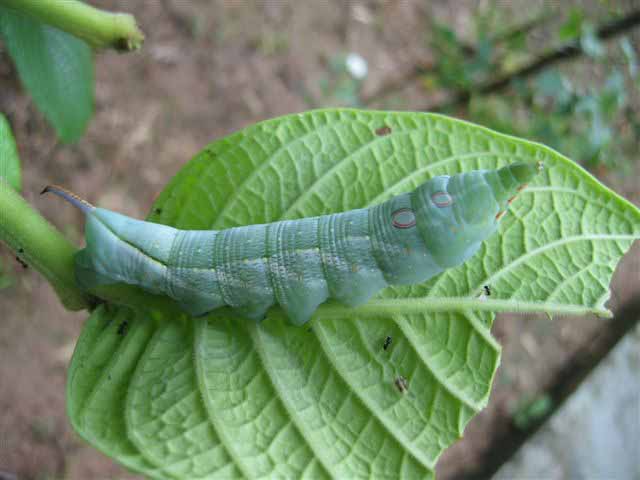
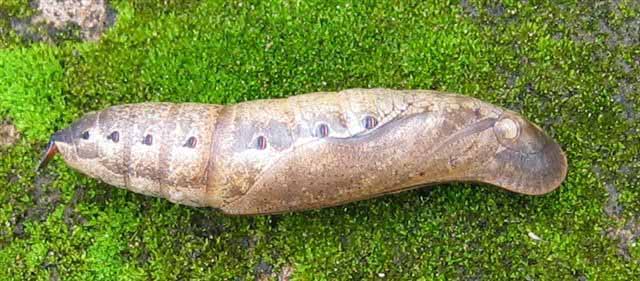
Moths emerge approximately one-two months after larvae pupate.
Use your browser "Back" button to return to the previous page.
Goto Main Sphingidae Index
Goto Macroglossini Tribe
Goto Central American Indices
Goto Carribean Islands
Goto South American Indices
Goto U.S.A. tables
The pronunciation of scientific names is
troublesome for many. The "suggestion" at the top of the page is
merely a suggestion. It is based on commonly
accepted English pronunciation of Greek names and/or some
fairly well accepted "rules" for latinized scientific names.
The suggested pronunciations, on this page and on other pages,
are primarily put forward to assist those who hear with internal
ears as they read.
There are many collectors from different countries whose
intonations and accents would be different.
Jean Marie Cadiou writes, "When I say "Xylophanes" in English I
pronounce it something like "Zailophanees", with the emphasis on the
"o". The French pronounce it differently, something like
"Kzeelophaness" with no emphasis, and the Germans yet in a
different way..."
In Greek myth, Phanes is the golden winged Primordial Being who
was hatched from the shining Cosmic Egg that was the source of the
universe. He personifies light emerging from chaos.
"Xylo" is the Greek word for wood.
The specimen type for the genus
Xylophanes is Xylophanes anubus. Perhaps ? when Hubner
examined this species, the yellow-orange and brown tones of the
forewings suggested wings of wood.
The species name "chiron" comes
from Greek mythology where Chiron is the wise centaur who
tutors Achilles, Hercules and Asclepius. I do not know the source of
the subspecies name.








